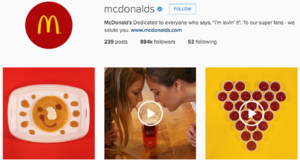From Discussions VOL. 12 NO. 2The Burrito Behemoth: Chipotle Mexican Grill and Its Model for Success
By
Discussions 2016, Vol. 12 No. 2 | pg. 1/1 AbstractChipotle Mexican Grill has revolutionized the fast food industry. In a short time, the brand has served as inspiration for the growing "fast casual" segment of the food industry and has become an American cultural phenomenon. Through its use of social media and corporate social responsibility marketing strategies, the brand has adapted to a growing segment of the consumer market and has taken the United States by storm. Today, Chipotle has turned its focus to its presence as an international brand. This paper analyzes Chipotle's marketing tactics, how they were applied to its London branches as well as implications for the brand's success abroad. IntroductionOn Monday, April 13th, 2015, former senator and presidential candidate Hillary Clinton was caught on camera dining at a burrito chain called Chipotle Mexican Grill in Maumee, Ohio (Haberman, 2015). When news later broke of former senator Clinton dining at the outlet unnoticed, American media covered the event extensively. While the stories were humorous, some referencing her campaign video and her commitment to serve "everyday Americans" (Haberman, 2015), the coverage revealed much about the status of this current industry giant. Clinton's taste for Chipotle humanized her in the eyes of many, showing that even prominent presidential candidates still love their burritos. It made her relatable without her trying to be so, as she was seen in the restaurant wearing large sunglasses evidently not trying to make a scene. Similar stories ran when President Barack Obama visited a Chipotle in Washington, D.C., wherein the media mocked the world leader for breaking the taboo of reaching over the glass barrier separating servers and customers ("#Chipotus," 2014). Chipotle has become a point of relatability for Americans, only solidifying its place as a hallmark of American culture. Yet it was not until the past five years that Chipotle began expanding to signify itself as a global brand. This paper will examine the heart of the brand, its marketing tactics, and its move to penetrate the London market as it strives to become the leader of the international burrito market. Chipotle's Brand DevelopmentCompany BackgroundFounded in 1993 by Steve Ells, Chipotle Mexican Grill has grown to become one of the largest and fastest-growing restaurant chains in the world (Ragas & Roberts, 2009). The story of Chipotle, however, is unique in almost every way. When Ells set out to create Chipotle, he had a simple mission in mind: "Food with Integrity." He wanted to create a brand that focused on fresh, natural ingredients that allowed for customization yet still maintained the atmosphere of a fast food restaurant (Adamy, 2007). In doing so, what Ells did was create a new industry. While Chipotle executives still refer to what they serve as fast food, the industry refers to the Chipotle model as "fast casual" and has associated the brand with the likes of Panera Bread Co. and other similar eateries. These restaurants offer more attractive interiors and food that is priced slightly higher than the average burger joint (Adamy, 2007). "He wanted to create a brand that focused on fresh, natural ingredients that allowed for the customization yet still maintained the atmosphere of a fast food restaurant (Adamy, 2007)." Chipotle's unique model proved to be a success and attracted a variety of investors. Among these investors was fast food industry giant McDonald's Corp. In 1998, Ells sold an interest to the company that allowed Chipotle to operate autonomously while still benefitting from McDonald's relationships and resources (Ragas & Roberts, 2009). The details of this agreement were critical, for it is likely that because Chipotle was able to operate independent of external pressure, the company's innovate model changed the food service industry. As Kumar (2014) notes, innovation is not only the cornerstone of growth, but it can also affect entire industries. Chipotle was able to do just this, essentially changing the face of American fast food with the introduction of the "fast casual" model. As a trend-setter in the category (Yohn, 2014), Chipotle established a model that allows customers to tailor their meals and still have them ready quickly (Strom, 2015a). Today, multiple brands can be seen following in Chipotle's footsteps, adapting the framework to other cuisines such as pizza and Asian fusion (Pino, 2014) as well as Indian (Birdsall, 2013) among others. Due to corporate restructuring, McDonald's fully divested its ownership interest in Chipotle in October 2006, resulting in a large financial gain for the company (Arndt, 2007, cited in Ragas & Roberts, 2009). Business & PurposeHoeffler and Keller (2002) note, "The challenge for marketers in building a strong brand is ensuring that customers have the right type of experiences with products and services and their accompanying marketing programs so that the desired thoughts, feelings, images, beliefs, perceptions, opinions, and so on become linked to the brand" (p. 79). Chipotle was able to build its brand name by undertaking the principle of what Ells calls "Food with Integrity." Continuing under this paradigm, Chipotle focuses on using "ingredients that are sustainably grown and naturally raised with respect for the environment, animals and people who grow or raise the food" (Ragas & Roberts, 2009, p. 265). Essentially, Chipotle wants people to consider where their food comes from and has committed itself to using quality ingredients to make its product (Klamm, 2012). This is evidenced by the fact that the brand manages to spend more money on ingredients than it does on payroll (Yohn, 2014). Chipotle's distinctive philosophy is referred to as corporate social responsibility. According to Ragas and Roberts (2009), corporate social responsibility has become important to companies, and when companies commit themselves to social responsibility, consumers take notice. Therefore, brands aggressively market their socially conscious actions to make sure their customers know about them. Chipotle wants its customers to know it is committed to serving "Food with Integrity" because it helps build the perception that the company stands for something important and meaningful beyond good-tasting food (Ragas & Roberts, 2009). Moreover, the brand stands for quality not just in food, but also in service. Chipotle's President and Chief Operating Officer, Monty Moran, said in 2007, "We don't ever want [to emphasize] speed over great service" (Adamy, 2007, para. 20). This could be part of the reason industry experts have classified the brand outside of the typical fast food category. As customer loyalty can be influenced by positive interactions with employees (Ozuem, Thomas, & Lancaster, 2015b), emphasizing good service can have positive outcomes for the brand. Quality food and quality service are thus "puller" factors for developing customer loyalty (Ozuem et al., 2015b). For a brand to manage these difficult goals requires the company to have a strong corporate leadership. The innovative and determined leadership of Chipotle oversees that the brand is fulfilling its purpose and promises. Chipotle reflects what Ozuem, O'Keeffe, and Lancaster (2015a) refer to as a dependent leadership culture in which there are established positions of authority and leadership and in which operations are controlled from the top. Further, as Pino (2014) explains, Chipotle does not franchise; all of its Mexican restaurants are owned corporately. ClienteleMore so than many other brands, Chipotle seems to know its customer base well. The company has learned that its customers notice the difference in flavor from natural meats and fresh vegetables and that they're willing to pay extra for it (Yohn, 2014). By focusing on its corporate social responsibility campaign of "Food with Integrity," the brand has likely managed to increase its market share. According to Mahoney (2008) and Sass (2008) cited in Ragas and Roberts (2009), a growing percentage of consumers claim they are increasingly likely to buy from brands engaging in such programs. Thus, it is clear that the brand caters its product to the demands of the market and its consumers. Despite the restaurant chain's initial struggle to maintain customers because of its notoriously long queues (Adamy, 2007), today it has come to symbolize the tastes of the millennial generation (Strom, 2015a). Brand ExtensionsDue to Chipotle's comparatively rapid success, the company has turned its focus to building new brands. Although new brands may fail due to profit-related issues, failing to meet sales targets, or inadequate marketing support (Singh, Scriven, Clemente, & Lomax, 2012), Chipotle benefits from having the "near instant" loyalty of its existing customers (Singh et al., 2012, p. 235). At the time of the writing of this paper, Chipotle has already introduced two new brands: ShopHouse Southeast Asian Kitchen and Pizzeria Locale. ShopHouse serves Asian-inspired cuisine in bowls and Pizzeria Locale serves a personalized twist on pizza (Pino, 2014). Both outlets allow consumers to customize their product according to their tastes, just as Chipotle does. Also similar to Chipotle, each brand focuses on fresh, responsibly-sourced ingredients, time-honored cooking techniques, tons of prep work, and incredibly speedy turnaround times (Pino, 2014). What is particularly notable about these brand extensions, however, is the way in which they were developed. Chipotle's Director of Concept Development, Tim Wildin, said of ShopHouse, "None of this was driven by market research or customers. Nothing...It would be totally different and it probably wouldn't be successful. This was driven by a love of really good food" (Pino, 2014, para. 3). For Pizzeria Locale, Ells invested in the business of two old friends who were looking to expand their Coloradobased pizza joint (Pino, 2014). Once again, Chipotle did away with traditional marketing conventions and instead chose to follow its principles. Currently, there are ten ShopHouse locations in the United States ("Locations", n.d.) and one Pizzeria Locale (Pino, 2014). Chipotle's Promotional StrategiesWebpage & PositionWhen visiting Chipotle's primary website, it immediately becomes clear what their corporate vision is. On the brand's site for its branches in the United States and Canada, a graphic prominently and proudly displays Chipotle's commitment to its "Food with Integrity" philosophy by explaining the recent changes the company is making. A secondary focus is grassroots advertising such as community events, specifically the Chipotle Cultivate Festival where the company hosts free live music and food tastings among other things. Its menu and nutritional information come after that, followed by locations. Due to Chipotle being a well-known brand in the United States, the company likely does not feel the need to advertise its product offerings most prominently on its American site. Chipotle takes a different approach on its European sites. Its U.K., French, and German sites are all designed identically, more prominently displaying the brand's product than its mission. This is likely due to the company still being new in these areas and needing to establish itself as a familiar brand with these consumers. The only difference between these websites is the language used, which varies to make accommodations for the dominant language spoken in each country. Each site is aesthetic, using large photos of ingredients and finished burritos to appeal to customers and draw them in. The company adopts a similar strategy for its social media presence, remaining loyal to the "Food with Integrity" and customer-first ethos (Klamm, 2012). PromotionThe means by which Chipotle promotes its product in different places is modern and differs from traditional marketing strategies. Chipotle prefers to focus on public relations rather than advertising because according to Ells, "Advertising is not believable" (Arndt, 2007, para. 2). The burrito giant has built its brand name by using a grassroots strategy that focuses on local events, media relations, contests, giveaways, philanthropy, and sponsorship (Ragas & Roberts, 2009). In 2008, Chipotle executives said they would rather spend $35,000 giving away food and "connecting with customers in a personal way" than buying a fullpage ad in The New York Times (Ragas & Roberts, 2009, p. 274). By focusing on its customers, Chipotle actualizes a concept intricately tied to marketing. "Deeply rooted in the concept of leadership, marketing is the belief that marketing revolves around the customer" (Ozuem et al., 2015a). Chipotle maintains this principle as one of its core values. The brand is able to accomplish a high level of interaction with customers largely through its social media presence. Chipotle's emphasis on social media marketing is a bold and effective move. As Kumar (2014) cites, companies are shifting to such marketing tactics "in a bid to engage with consumers on a onetoone level," which Chipotle clearly does (p. 18). According to a Nation's Restaurant News study-conducted in 2011, it was found that Chipotle responds to 83% of Facebook posts – more than any other fast casual restaurant (Klamm, 2012). Furthermore, approximately 90% of company Twitter activity comes from responding to customers through @-mentions (Klamm, 2012). "The brand is able to accomplish a high level of interaction with customers largely through its social media presence." There are a multitude of reasons why Chipotle puts so much effort into social media marketing and one-on-one communication with customers. One reason is that they value their customers as individuals (Klamm, 2012), but also because interaction will foster customer loyalty, which in turn will lead to customer retention (Ozuem et al., 2015b). Moreover, a two-way communication flow is needed to respond to customer difficulties (Ozuem et al., 2015b). Social media also allows Chipotle to promote its corporate social responsibility programs. By telling consumers about its "Food with Integrity" program, Chipotle is able to deepen a customer's emotional connection with the brand (Ragas & Roberts, 2009). Perhaps most importantly, effective societal marketing allows brands to "charge higher prices, increase market share and engender greater brand loyalty and treatment from stakeholders" (Bloom, Hoeffler, Keller, & Meza, 2006, cited in Ragas & Roberts, 2009). International ExpansionIn the past few years, Chipotle has expanded to Paris (Pham, 2012), Frankfurt ("Chipotle Mexican Grill," 2013), London ("Chipotle Opens Restaurant," 2010) and Canada (DeMontis, 2008). In 2013, three years after Chipotle entered the U.K. market, Londoners had not warmed up to its oversized burritos (Wong, 2013). American-style Mexican food seemed to have less allure in the English market given the dearth of Mexicans in the U.K. (Wong, 2013). Beyond that, the price of the brand's offerings were seen as too high for many Londoners (Wong, 2013). Given these factors, it appears the brand adopted an ethnocentric approach to branding, just as many other American companies have (Cayla & Arnould, 2008). Cross-national differences prevent the use of blanket marketing strategies (Ozuem et al., 2015b). What Chipotle needed to do was glocalize its marketing strategy, meaning it needed to particularize its global product to a local market (Matusitz, 2010). According to Kumar (2014), companies must accommodate region-specific cultural norms, which Chipotle did not do with respect to their portions and prices. Chipotle, however, did not feel the need to significantly adapt its product to the European market. According to Van Tan (2010), Chipotle's initial approach in London made sense as the chain seemed better suited for Europe where there was already an appreciation for local and sustainably-raised ingredients. The only marked change they made was to substitute the spelling of words with the Queen's English spelling so that "flavor" was respelled "flavour" on its London packaging (Van Tan, 2010). Then in 2014, Chipotle hired Mother London, the largest independent advertising agency in the U.K., as its London marketing partner (Faull, 2014). Today, their campaign highlights the brand's attitude toward choosing the right ingredients, and even playfully mocks the unfamiliarity most Londoners have with Mexican cuisine (Faull, 2014). The significant standardization found in Chipotle's marketing techniques is not necessarily a negative quality. As Backhaus, Muhlfeld and Van Doorn (2001) state, companies pursue a policy of standardization to reduce costs and gain efficiency. At the same time, doing so prevents image confusion and customer irritation (Backhuas et al., 2001; Cayla & Arnould, 2008). Overall, Chipotle's decision to keep the central aspects of its marketing campaign the same across the globe could thus be seen as a strength. They standardize several aspects such as the creative selling proposition and the actual elements and language of the ad (Backhaus et al., 2001). The company was conscious of needing to adapt to cultural norms but also thought their product met the needs of European consumers. Thus, Chipotle is actually not ethnocentric, but operates under a geocentric marketing orientation. The chain seems to have turned things around abroad as customers are now responding positively. It opened its seventh London location in the summer of 2015 (Witts, 2015). The Fruits of Corporate Social ResponsibilityConsistencyAs a brand that partakes in corporate social responsibility, it is critical that Chipotle fulfills its promises. Ragas & Roberts (2009) write that brands that make strong emotional connections with their customers risk serious backlash if they abandon their emotional branding promises; thus, Chipotle must tread carefully. On the 26th of April 2015, Chipotle fully realized its "Food with Integrity" vision when it announced that it would no longer serve food with genetically altered ingredients (Strom, 2015b). Granted, the company acknowledges that some of the soft drinks it sells are likely to contain sweeteners made from modified corn, and that some of its meat and dairy supplies come from animals fed modified grains (Strom, 2015b). Despite it being cheaper and more profitable to use non-locally produced and genetically-modified ingredients, Chipotle sticks to its value system everywhere it has a presence. As Srnka (2004) argues, consumer values and desires are critical for companies to consider. Chipotle is wary of this as evidenced by their commitment to not serve genetically-modified foods. Beyond staying true to their "Food with Integrity" campaign, the company understands what customers want when it comes to their food and caters to those desires. Success & ExpansionChipotle's staggering success can largely be attributed to its visionary leadership. Founder Steve Ells had a basic goal in mind with his "Food with Integrity" mission and carried it out masterfully. Under Ells's leadership, the Chipotle brand thrives due to its compelling vision, clear organizational identity, effective culture for employee alignment and a deep understanding of consumer behavior (Ozuem et al., 2015a). "Despite it being cheaper and more profitable to use non-locally produced and genetically-modified ingredients, Chipotle sticks to its value system everwhere it has a presence." Additionally, Chipotle benefits from its recognition of the importance of interacting with customers. Charles (2007) cited in Ozuem et al. (2015a) argues that when a company operates customer-centrically, it receives a positive return on investment, satisfied shareholders and stakeholders from business and the community, and a sustainable business future. Chipotle's broad social media presence is its recognition of this fact. The company makes an active effort to respond to all messages on Facebook and Twitter from around the world, valuing its personal connection with consumers. Hence, Chipotle has improved its status abroad and continues to thrive as a dynamic and revolutionary company. AcknowledgementsI would like to thank Dr. Wilson Ozuem of Regent's University London for providing a skeletal structure for this paper. BiographyNealay Vasavda is a fourth-year student of Anthropology and Political Science at Union College in Schenectady, New York with a minor in Cyberethics. He has presented research projects at the National Conference on Undergraduate Research as well as at a conference of the Northeastern Anthropological Association. Upon graduation, he will be pursuing his Master's Degree in Comparative Social Policy at the University of Oxford. In his free time, he enjoys running and watching documentaries and politcal thrillers. ReferencesAdamy, J. (2007, November 3). Burrito chain assembles a winning combo. Wall Street Journal. Retrieved from http://www.wsj.com/articles/ SB119577962200001637 Backhaus, K., Muhlfeld, K., & Van Doorn, J. (200). Consumer perspectives on standardization in international advertising: A student sample. Journal of Advertising Research, 41(5), 53-61. doi: 10.2501/JAR-41-5-53-61 Birdsall, J. (2013). The Indian Chipotle exists right now in San Francisco at Tava. Retrieved from http://www.chow.com/food-news/132768/tava-indianchipotle-exists-right-now-in-san-francisco/ Cayla, J. & Arnould, E. (2008). A cultural approach to branding in the global marketplace. Journal of International Marketing, 16, 86-112. doi: http://dx.doi. org/10.1509/jimk.16.4.86 Cheshes, J. (2015, February 6). The Chipotle effect: How chefs are reinventing fast food. Wall Street Journal. Retrieved from http://www.wsj.com/articles/the-chipotle-effecthow-chefs-are-reinventing-fast-food-1423258757 DeMontis, R. (2008, August 13). Come down to Life Square for free burritos. Toronto Sun, p. 40 Faull, J. (2014, March 20). Chipotle names Mother London as first UK creative agency. The Drum. Retrieved from http://www.thedrum.com/news/2014/03/20/chipotle-names-mother-london-first-uk-creative-agency Haberman, M. (2015, April 13). Hillary Clinton, just an unrecognized burrito bowl fan at Chipotle. The New York Times. Retrieved from http://www.nytimes.com/2015/04/14/us/politics/on-the-road-hillary-clinton-stops-forlunchat-chipotle-and-goes-unrecognized.html Hoeffler, S., & Keller, K. (2002). Building brand equity through corporate societal marketing. Journal of Public Policy & Marketing, 21(1), 78-89. doi: http://dx.doi.org/10.1509/jppm. 21.1.78.17600 Klamm, D. (2012). How Chipotle uses social media to cultivate a better world. Retrieved from http://mashable.com/2012/03/21/chipotle-social-media/ Kumar, V. (2014). Understanding cultural differences in innovation: A conceptual framework and future research directions. Journal of International Marketing, 22(3), 1-29.doi: http://dx.doi.org/10.1509/jim.14.0043 Matusitz, J. (2010). Disneyland Paris: A case analysis demonstrating how glocalization works. Journal of Strategic Marketing, 18(3), 223-237. Ozuem, W., O'Keeffe, A., & Lancaster, G. (2015a). Leadership marketing: An exploratory study. Journal of Strategic Marketing, 23(1), 1-25. doi: 10.1080/0965254X.2014.1001867 Ozuem, W., Thomas, T., & Lancaster, G. (2015b). The influence of customer loyalty on small island economies: An empirical and exploratory study. Journal of Strategic Marketing, 1-23. doi: 10.1080/0965254X.2015.1011205 Pham, A. (2012, May 31). On a testé le premier Chipotle Mexican Grill à Paris 9e. L'Express. Retrieved from http://www.lexpress.fr/styles/saveurs/recette/on-a-teste-le-premier-chipotle-mexican-grill-a-paris-9e_1120953.html Pino, I. (2014). 10 things you need to know about Chipotle's pizza and Asian concepts. The Motley Fool. Retrieved from http://www.fool.com/investing/general/2014/07/02/10-things-you-need-to-know-about-chipotles-pizza-a.aspx Ragas, M. & Roberts, M. (2009). Communicating corporate social responsibility and brand sincerity: A case study of Chipotle Mexican Grill's ‘Food with Integrity' program. International Journal of Strategic Communication, 3(4), 264–280. doi: 10.1080/15531180903218697 Reimer, M. (2011, September 16). Chipotle opens first Asian-style restaurant in D.C. Business Insider. Retrieved from http://www.businessinsider.com/chipotleopens-first-asian-style-restaurant-in-dc-2011-9?IR=T ShopHouse Kitchen Locations. (2016). [Interactive map of U.S. ShopHouse Kitchen locations]. Retrieved from http://shophousekitchen.com/locations Singh, J., Scriven, J., Clemente, M., & Lomax, W. (2012). New brand extensions: Patterns of success and failure. Journal of Advertising Research, 52(2), 234-242. doi: 10.2501/JAR-52-2-234-242 Srnka, K. (2004). Culture's role in marketers' ethical decision making: An integrated theoretical framework. Academy of Marketing Science Review, 2004(1), 1-31. Strom, S. (2015a, April 21). Chipotle posts another quarter of billion-dollar sales. New York Times. Retrieved from http://www.nytimes.com/2015/04/22/business/chipotle-quarterly-earnings.html Strom, S. (2015b, April 26). Chipotle to stop using genetically altered ingredients. New York Times. Retrieved from http://www.nytimes.com/2015/04/27/business/chipotle-to-stop-serving-genetically-altered-food.html Van Tan, R. (2010, February 1). Growing global. QSR Magazine. Retrieved from http://www2.qsrmagazine.com/articles/features/138/global_growth-3.phtml Witts, S. (2015, April 13). Chipotle opening seventh London site. Big Hospitality. Retrieved from http://www.bighospitality.co.uk/Venues/Chipotle-openingseventh-London-site Wong, V. (2013, February 26). Why Chipotle sales lag in London. Bloomberg Business. Retrieved from http://www.bloomberg.com/bw/articles/2013-02-26/why-chipotle-salesarelow-in-london Yohn, D. (2014, March 14). How Chipotle changed American fast food forever. Fast Company. Retrieved from http://www.fastcompany.com/3027647/lessonslearned/how-chipotle-changed-american-fast-food-forever (2010, May 10). Chipotle opens restaurant in London, its 1st in EU. Denver Business Journal. Retrieved from http://www.bizjournals.com/denver/stories/2010/05/10/daily4.html (2013, June 6). Chipotle Mexican Grill eröffnet in der Skyline Plaza. Genuss Magazine. Retrieved from http://www.genussmagazin-frankfurt.de/gastro_ news/Auf-und-Zu-19/Ol-Chipotle-Mexican-Grill-eroeffnet-in-der-SkylinePlaza-18858.html?newsletter_id=1469 (2014, June 24). #Chipotus Ew! Obama's fast food flub. Retrieved from http://edition.cnn.com/videos/bestoftv/2014/06/24/newday-inside-politics-chipotusew-obamas-fast-food-flub.cnn Suggested Reading from Inquiries Journal
Inquiries Journal provides undergraduate and graduate students around the world a platform for the wide dissemination of academic work over a range of core disciplines. Representing the work of students from hundreds of institutions around the globe, Inquiries Journal's large database of academic articles is completely free. Learn more | Blog | Submit Latest in Economics |



















